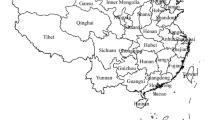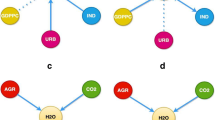Abstract
The theory of water poverty has undergone extensive development since it was first proposed, but there are still deficiencies in its definition and evaluation at the micro-subject level as well as the research of endogenous drivers analysis. In this regard, this paper takes the main body of micro farmers as the research object, and makes use of 603 micro farmers’ data in Shaanxi and Ningxia, China in order to carry out the measurement of farmers’ water poverty and its endogenous drivers analysis. First, we define the concept of farmers’ water poverty at the micro-scale, and propose a farmers’ water poverty index (FWPI) applicable to the evaluation of micro-level subjects and measure it. Then, an empirical analysis of the endogenous driving paths of farmers’ water poverty is conducted by constructing a partial least square structural equation model (PLS-SEM) with reference to the Drivers-Pressures-State-Impact-Response (DPSIR) causality model. All of the pertinent theoretical hypotheses put forward in this study were found to pass the test well. In this regard, the study reveals in detail the specific pathways of the drivers of farmers’ water poverty. It also discovers that the drivers’ impacts on the status of farmers’ water poverty vary, with the effects produced by P_Resource and D_Capacity being prominent. Finally, the study provides countermeasures as well as suggestions for improving the theory of water poverty and alleviating farmers’ water poverty from an endogenous driver standpoint.


Similar content being viewed by others
Data Availability
Available from the first author upon request.
Notes
Shaanxi Province Department of water resources (2021) Norm of water intake for industries in Shaanxi. http://slt.shaanxi.gov.cn/zfxxgk/zcjd/202012/t20201228_2147053.html. Accessed 1 February 2023.
Ningxia Water Conservancy (2020) General Office of the People’s Government of the Autonomous Region on the issuance of the norm of water for relevant industries in Ningxia Hui Autonomous Region (revised). http://slt.nx.gov.cn/xxgk_281/fdzdgknr/wjk/zzqwj/202112/t20211215_3225337.html. Accessed 1 February 2023.
References
Al-Faraj FAM, Tigkas D, Scholz M (2016) Irrigation efficiency improvement for sustainable agriculture in changing climate: a Transboundary Watershed between Iraq and Iran. Environ Process 3:603–616
Bhatt D, Sonkar G, Mall RK (2019) Impact of Climate variability on the Rice yield in Uttar Pradesh: an agro-climatic zone based study. Environ Process 6:135–153
Borongan G, NaRanong A (2022) Factors in enhancing environmental governance for marine plastic litter abatement in Manila, the Philippines: a combined structural equation modeling and DPSIR framework. Mar Pollut Bull 181:113920
Cao H (2005) An initial study on DPSIR Model. Environ Sci Technol S1:110–111 (in Chinese)
Cooper P (2013) Socio-ecological accounting: DPSWR, a modified DPSIR framework, and its application to marine ecosystems. Ecol Econ 94:106–115
Fornell C, Cha J (1994) Partial least squares. In: Bagozzi RP (ed) Advanced Methods of Marketing Research. Blackwell Publishers, Cambridge, MA, pp 52–78
Forouzani M, Karami E (2011) Agricultural water poverty index and sustainability. Agron Sustain Dev 31(2):415–431
Forouzani M, Karami E, Zamani GH, Moghaddam KR (2013) Agricultural water poverty: using Q-methodology to understand stakeholders’ perceptions. J Arid Environ 97:190–204
Gari SR, Newton A, Icely JD (2015) A review of the application and evolution of the DPSIR framework with an emphasis on coastal social-ecological systems. Ocean & Coastal Management 103:63–77
Hair J, Alamer A (2022) Partial least squares structural equation modeling (PLS-SEM) in second language and education research: guidelines using an applied example. Res Methods Appl Linguistics 1(3):100027
Hair J, Hult G, Ringle C, Sarstedt M (2022) A primer on partial least squares structural equation modeling (PLS-SEM), 3nd edn. SAGE
He Y, Wang Y, Chen X (2019) Spatial patterns and regional differences of inequality in water resources exploitation in China. J Clean Prod 227:835–848
Henseler J, Ringle CM, Sarstedt M (2015) A new criterion for assessing discriminant validity in variance-based structural equation modeling. J Acad Mark Sci 43(1):115–135
Hu LT, Bentler PM (1999) Cutoff criteria for fit indexes in covariance structure analysis: conventional criteria versus new alternatives. Struct Equation Modeling: Multidisciplinary J 6(1):1–55
Hussain Z, Wang Z, Wang J et al (2022) A comparative Appraisal of classical and holistic water scarcity indicators. Water Resour Manage 36(3):931–950
Jemmali H (2018) Water Poverty in Africa: a review and synthesis of issues, potentials, and Policy Implications. Soc Indic Res 136(1):335–358
Kelble CR, Loomis DK, Lovelace S et al (2013) The EBM-DPSER conceptual model: integrating ecosystem services into the DPSIR framework. PLoS ONE 8(8), e70766
Ladi T, Mahmoudpour A, Sharifi A (2021) Assessing impacts of the water poverty index components on the human development index in Iran. Habitat Int 113:102375
Li Y, Liu Y, Yan X (2012) A DPSIR-Based Indicator System for Ecological Security Assessment at the Basin Scale. Acta Scientiarum Naturalium Universitatis Pekinensis 48(06):971–981 (in Chinese)
Liu J, Wang J, Li H, Li Y (2013) A mathematic model for rational domestic water demand considering climate and economic development factors. J Hydraul Eng 44(10):1158–1164 (in Chinese)
Liu W, Zhao M, Xu T (2018) Water Poverty in Rural Communities of Arid Areas in China. Water 2018, 10(4), 505
Luo L (2020) Application of PLS-SEM Multivariate Data Analysis on Sports Spectators Research. J Shanghai Univ Sport 44(11):86–94 (in Chinese)
Manandhar S, Pandey VP, Kazama F (2012) Application of Water Poverty Index (WPI) in nepalese context: a case study of Kali Gandaki River Basin (KGRB). Water Resour Manage 26(1):89–107
Nadeem AM, Cheo R, Shaoan H (2018) Multidimensional analysis of Water Poverty and Subjective Well-Being: a Case Study on Local Household Variation in Faisalabad, Pakistan. Soc Indic Res 138(1):207–224
Organization of Economic Co-operation and Development. OECD core set of indicators for environmental performance review. OECD, Paris, Environmental Monograph, 1993, No 83.
Pandey VP, Manandhar S, Kazama F (2012) Water Poverty Situation of medium-sized river basins in Nepal. Water Resour Manage 26(9):2475–2489
Pérez-Foguet A, Giné Garriga R (2011) Analyzing Water Poverty in basins. Water Resour Manage 25(14):3595
Qi X, Feng K, Sun L et al (2022) Rising agricultural water scarcity in China is driven by expansion of irrigated cropland in water scarce regions. One Earth 5(10):1139–1152
Rekolainen S, Kämäri J, Hiltunen M, Saloranta TM (2003) A conceptual framework for identifying the need and role of models in the implementation of the water framework directive. Int J River Basin Manage 1(4):347–352
Shen J, Zhao Y, Song J (2022) Analysis of the regional differences in agricultural water poverty in China: based on a new agricultural water poverty index. Agric Water Manage 270:107745
Shen J, Zhang H, Zhao Y, Song J (2023) An examination of the mitigation effect of vegetation restoration on regional water poverty: based on panel data analysis of 9 provinces in the Yellow River basin of China from 1999 to 2019. Ecol Ind 146:109860
Sullivan C (2002) Calculating a Water Poverty Index. World Dev 30(7):1195–1210
Sun C, Tang W, Zou W (2013) Research on the coordinating relation among Rural Water Poverty, Urbanization and Industrialization process in Chin. China Soft Science (07), 86–100. (in Chinese)
Sun C, Dong L, Zheng D (2014) Rural water poverty risk evaluation, obstacle indicators and resistance paradigms in China. Resour Sci 36(05):895–905 (in Chinese)
Sun C, Wu Y, Zou W, Zhao L, Liu W (2018) A Rural Water Poverty Analysis in China using the DPSIR-PLS Model. Water Resour Manage 32(6):1933–1951
Teshome M (2015) Farmers’ vulnerability to climate change-induced water poverty in spatially different agro-ecological areas of northwest Ethiopia. J Water Clim Change 7(1):142–158
Wang C, Zhou Y, You K, Liu Y (2021) Analysis of Carbon Emissions Accounting and influencing factors of Water-Energy Consumption Behaviors in Beijing residents. Chin J Environ Manage 13(03):56–65 (in Chinese)
Wilk J, Jonsson AC (2013) From Water Poverty to Water Prosperity: a more Participatory Approach to studying local Water Resources Management. Water Resour Manage 27(3):695–713
Yu M, Wang C, Liu Y, Olsson G, Bai H, Resources (2018) Conserv Recycling 130, 190–199
Zeleke G, Teshome M, Ayele L (2023) Farmers’ livelihood vulnerability to climate-related risks in the North Wello Zone, northern Ethiopia. Environ Sustain Indic 17:100220
Zhang H, Wang L (2019) Evaluation and spatio-temporal analysis for agricultural water poverty in China. Resources Science 2019, 41(1), 75–86. (in Chinese)
Funding
This work was supported by the Natural Science Basic Research Program of Shaanxi (Grant numbers [2021JM-112]) and the National Social Science Fund of China (Grant numbers [22XGL022]).
Author information
Authors and Affiliations
Contributions
Jinlong Shen (data collection, methodology and data analysis, conceptualization, writing, and editing) Jianfeng Song (methodology and data analysis, supervision, conceptualization, writing, review) Jiafen Li (data collection, methodology and data analysis, editing) Yu Zhang (methodology, editing and prepared Figs. 1 and 2), All authors reviewed the manuscript.
Corresponding author
Ethics declarations
Ethical Approval
The submitted work is original and has not been published elsewhere in any form or language.
Consent to Participate
All the authors agree with the participation of this article.
Consent to Publish
All the authors agree with the publication of this article.
Competing Interests
The authors declare that they have no conficts of interest related to this work.
Additional information
Publisher’s Note
Springer Nature remains neutral with regard to jurisdictional claims in published maps and institutional affiliations.
Rights and permissions
Springer Nature or its licensor (e.g. a society or other partner) holds exclusive rights to this article under a publishing agreement with the author(s) or other rightsholder(s); author self-archiving of the accepted manuscript version of this article is solely governed by the terms of such publishing agreement and applicable law.
About this article
Cite this article
Shen, J., Li, J., Zhang, Y. et al. Farmers’ Water Poverty Measurement and Analysis of Endogenous Drivers. Water Resour Manage 37, 4309–4326 (2023). https://doi.org/10.1007/s11269-023-03554-5
Received:
Accepted:
Published:
Issue Date:
DOI: https://doi.org/10.1007/s11269-023-03554-5




